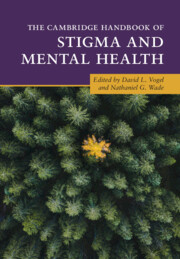Book contents
- The Cambridge Handbook of Stigma and Mental Health
- The Cambridge Handbook of Stigma and Mental Health
- Copyright page
- Contents
- Figures
- Tables
- Contributors
- 1 Introduction to the Handbook of Stigma and Mental Health
- Part I Understanding Stigma and Mental Health
- Part II Impact of Stigma on Mental Health
- 5 Time Trends in Public Stigma
- 6 Consequences of the Self-Stigma of Mental Illness
- 7 Self-Stigma of Seeking Help
- 8 Stigma and Suicide
- 9 Intellectual Disability Stigma
- Part III Stigma and Mental Health in Specific Contexts
- Part IV Reducing Stigma to Promote Mental Health
- Index
- References
8 - Stigma and Suicide
from Part II - Impact of Stigma on Mental Health
Published online by Cambridge University Press: 28 July 2022
- The Cambridge Handbook of Stigma and Mental Health
- The Cambridge Handbook of Stigma and Mental Health
- Copyright page
- Contents
- Figures
- Tables
- Contributors
- 1 Introduction to the Handbook of Stigma and Mental Health
- Part I Understanding Stigma and Mental Health
- Part II Impact of Stigma on Mental Health
- 5 Time Trends in Public Stigma
- 6 Consequences of the Self-Stigma of Mental Illness
- 7 Self-Stigma of Seeking Help
- 8 Stigma and Suicide
- 9 Intellectual Disability Stigma
- Part III Stigma and Mental Health in Specific Contexts
- Part IV Reducing Stigma to Promote Mental Health
- Index
- References
Summary
Theoretical conceptualizations of stigma distinguish three dimensions of stigma: public, perceived, and self-stigma, which encompass unconscious biases, stereotyping, negative attitudes, prejudice. and discrimination. These attitudes and behaviors may have negative effects for people who have suicidal thoughts, suicide attempts, or suicide bereavement, eliciting feelings of shame and embarrassment and reducing future disclosure and help-seeking behavior. Although suicide stigma is often conflated with mental illness stigma, a growing body of literature suggests suicide stigma manifests in unique ways. Assessment of suicide stigma has matured in the past decade, with several scales developed to measure the stigma of suicide attempt. Using these established measures, a body of research is continuing to identify the factors associated with suicide stigma and the impacts of suicide stigma, particularly on suicidality, depression, and help-seeking. Future research directions for this nascent research field include understanding the processes by which stigmatizing attitudes emerge, better establishing the roles of personal stigma and self-stigma on mental health outcomes, and testing stigma reduction programs in the general community. Meaningful engagement with people with lived experience of suicide and understanding cultural differences may lead to more effective and impactful approaches for reducing stigma and preventing suicide.
Keywords
- Type
- Chapter
- Information
- The Cambridge Handbook of Stigma and Mental Health , pp. 143 - 157Publisher: Cambridge University PressPrint publication year: 2022
References
- 1
- Cited by



